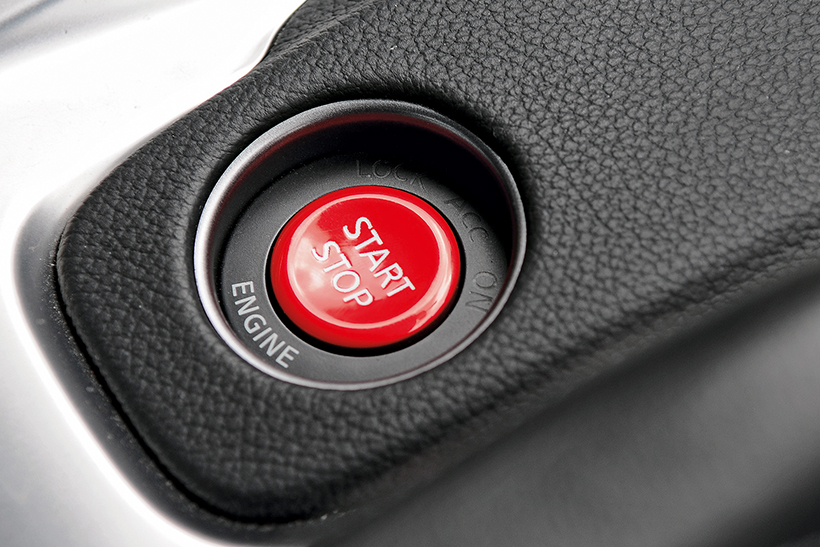Neglecting your car’s ignition system can mean losing power. Find out how to keep it running sweet with our in-depth guide.
Many people pay no attention to their ignition system, whether it’s a modified car with a tuned engine or not, until something goes wrong. It’s almost like it’s not even there. That’s until you get a misfire, or worse, a melted piston due to too much ignition and not enough fuel.
Then it becomes a case of learning very quickly and trying to put it right. Of course, you can bypass this agony by swotting up first. You never know, you might discover power you didn’t know you had! With this in mind, we thought we’d take a look at the essentials of ignition systems.
The fundamentals of any petrol engine are an ideal ratio of air to fuel. That, plus the ability to ignite that combustible charge at the correct time. This pushes the piston back down the bore, turning the crank, and everyone knows you need a spark to do this. The thing is, there’s a million ways to do the job. Although the fundamentals of spark production haven’t changed dramatically over the years, manufacturers have concentrated on removing mechanical discrepancies. In turn, making the whole system more efficient and reliable.
Hence, there’s a lot less ‘stuff’ in a modern ignition system than there used to be. However, it does help to know what the old stuff did in order to understand why modern systems are better.
Ignition Guide:
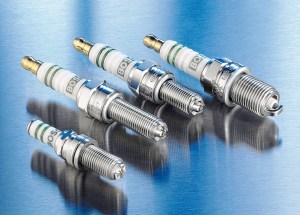
Plugs operate within a certain heat range.
Misfire
The most common ignition fault scenario is that jerking, coughing, and spluttering sensation that drives everyone nuts. It can happen on a standard car, of course, but another likely cause is that you’ve tuned your engine and your components don’t match. Tracing a misfire can be a real headache. The easiest and most logical place to start is the spark plugs. The plug provides the spark, which jumps an air gap from its central electrode to its earth. This requires a minimum of 14,000V, or 14kV, of electricity. In a modern car, that figure is likely to be 40kV or more, and generated by the coil. This acts like a transformer.
Your plugs will operate within a heat range, calculated with your engine’s standard level of performance in mind. However, if you increase performance, the engine’s operating temperature also rises. This additional heat needs to dissipate quickly to avoid overheating. This is why we install stuff like more efficient cooling systems and alloy heads.
Correctly gapped colder plugs
But you can also help with your plugs – a low-performance engine generally requires hotter plugs, since it needs to retain heat to provide a more efficient burn. You can see that if you raise the temperature within the combustion chamber by increasing the compression ratio (CR). Then, you generally need colder plugs, which means they’ll transfer heat away much faster. However, this is an area that you will need to consult your engine tuner about, as what needs doing will vary according to the modifications you’ve made.
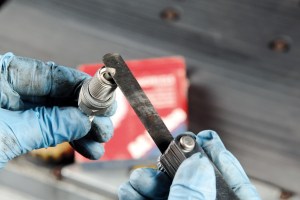
Plugs gapped correctly create optimum performance.
The gap is important, too. Again, a lower performing engine generally needs a bigger gap for the same reasons. A more compressed charge generally requires less spark duration, because it’s more combustible, although inevitably there are exceptions.
When to upgrade your spark plugs
Spark plugs generally last about 20,000 miles, but you should be checking them at every service interval. Don’t clean them with a wire brush or a sandblasting machine, as you’ll cause contamination (leading to shorts) or trapped abrasive (which can potentially damage the bores). But, if you’re that into plugs, you can tell a lot about how your engine is running and performing by ‘reading’ them. However, this is only truly effective with new ones and a hard drive of about 500–1000 miles. New plugs will have had less chance to foul up and will be a certain color – you won’t tell much from black, carbon-choked plugs. However, this could indicate that your plugs are too cold.
Generally, you should make sure to seat your plugs properly. There are two types: ones with washers (flat seat) and ones without (tapered). Check your car’s manual for the proper tightening sequence, but don’t overdo it. Incorrectly seated plugs will sap about 40 percent of your power.
Check out our spark plugs guide for more info on plugs.
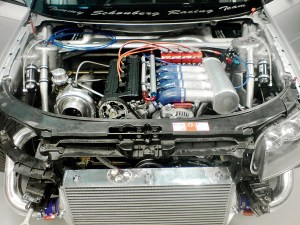
Coil upgrades are usually seen on older engines.
The Coil
A massive voltage, generated by the coil, creates the spart at the end of the plug. This steps up the power from a mere 12V to around 40kV using two circuits, called windings. The first one, known as the dwell period, is pretty important, as the longer it is, the more power you get in the second circuit. Current builds up in the low-tension first circuit (LT), and then a contact breaker directs it to the second circuit, where it’s further bumped up to that final voltage. Once that happens, the current moves within the high-tension circuit (HT).
Traditionally, circuit breakers, housed within the distributor, were mechanical, but nowadays they’re electronic. This is a far more efficient setup that is better able to cope with stricter emissions regulations. There’s a million and one ways to approach electronic ignition, but nowadays the ECU usually handles the circuit breaker from the LT to HT circuits.
It’s not that common to uprate the coil unless you’re dealing with an older engine. However, you may well fit a different type of coil according to the kind of ignition you’re using. Performance ignition may use differing dwell periods and electronic ignition types to produce a higher level of volts. The key is to produce constant dwell and constant high-power output, and there are several notably different ignition and coil types for this.
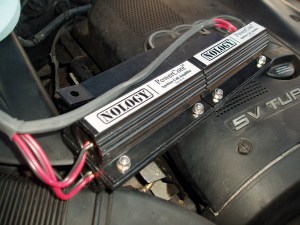
A CD system can burn straight through fouled-up plugs.
Capacitor Discharge (CD) Ignition
This type of ignition is worthy of note because it initially steps up the voltage in excess of 400V. Achieved using an oscillator (a transformer plus a rectifier), it is then stored in a capacitor. From there, it can be instantly discharged into the coil’s primary circuit. With that level of power starting off, you can imagine how many resulting volts occur on the HT side!
And because it’s pre-stored, the charge time is vastly increased. Suffice to say, the charge from this system is enough to burn straight through fouled-up plugs, although the downside is that the spark duration is relatively short – early systems actually blew out!
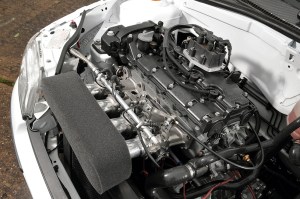
The coil pack eliminates the need for a distributor.
Coil Packs
Traditionally, one coil had to do the work for all the cylinders, and if you’re up to eight, that’s a lot of voltage to generate. Consequently, more modern engines use coil packs. One of these for a four-cylinder engine resembles a four-posted block of open-ended coils joined together, with an HT lead coming out of each one. Separate banks of the coil pack programmed to fire on each of the engine’s cycles (both compression and exhaust) in batches – controlling cylinders one and three and then two and four. One spark will ignite on the compression stroke whilst the other fires on the exhaust. Hence the name wasted spark.
This system is closely associated with distributor-less ignition, which is a feature of Ford’s EEC IV system. As the name suggests, there is no distributor. Using a crank trigger providing positioning and speed, the ECU controls the spark distribution. The ignition in this system is wholly mapped, which we’ll discuss in a second…
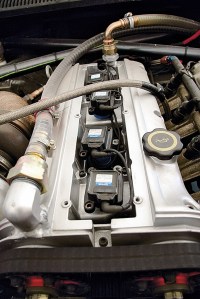
Direct injection systems have a coil for each plug.
Coil-On-Plug Direct Ignition
This is the natural progression from distributor-less ignition, and in a way it’s a similar concept to individual throttle bodies for each cylinder. Here, we have one coil for each plug. The primary winding induction is extremely fast and enormous power is produced. The typical layout has a short or virtually non-existent HT lead with a small coil pack perched on top of the cam/rocker cover, directly over the top of the spark plug.
The mighty LS-series Chevy V8s, such as the Corvette Z06’s LS6 and the supercharged LS9, use this system in conjunction with CD ignition. This is perhaps the ultimate progression of ignition technology for the time being – there’s no distributor, virtually no moving parts and very high reliability and power.
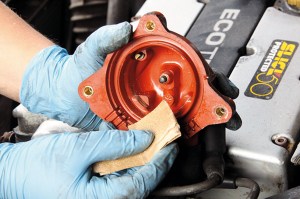
Distributors are present in many older cars.
Distributor Systems
Before the total elimination of this component, the distributor’s job was to point the HT in the correct direction for each spark plug. The distributor is a mechanical device revolving at half crank speed and is traditionally driven by the cam. A revolving rotor arm underneath the cap connects with the individual HT posts. On older systems, you can find a cam-operated contact breaker on the distributor’s central post. A mechanical system for advancing and retarding the ignition was another feature of older systems, but again, this is now taken care of by the ECU in the majority of cars.
If you’re still running a distributor system – and plenty of cars are – it’s important to keep them free from damp and to check for cracked caps and damaged rotor arms. However, it’s possible to do more damage than good if you’re too enthusiastic about cleanliness. A scratched cap could set up tracts, whilst polishing the rotor button can potentially wreck the insulating glaze. All you need to do is check for breakage and blow the dust out, then leave it!
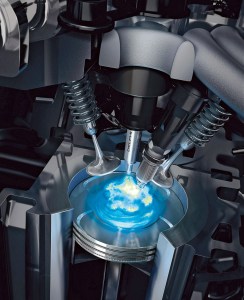
Ignition timing is the basis of your engine’s performance.
Ignition Timing & Advance
We’ve touched on advancing and retarding the ignition, and this is commonly controlled by the ECU, but it’s extremely important to grasp the concept, as it’s the basis of performance. Within the four-stroke cycle of the combustion engine, the piston travels pretty fast in the bore. The ideal situation is to have the intake charge ignite at its maximum point of compression, resulting in the most efficient burn driving the piston – preferably at the point of maximum power. Therefore, accuracy is paramount when timing these points.
The problem is that the piston has momentum, meaning it can carry past the point of max compression, causing the mixture to ignite too late (bent conrods can result if the same thing happens too early on the up-stroke). Although it might seem like an explosion to us, the charge is actually burning at a rate dictated by the amount of compression, the fuel’s octane rating and the air-to-fuel ratio (AFR).
So, the piston’s momentum and the burn time mean that the spark needs to fire early – in other words, at a point in ‘advance’ of the maximum point of compression. But there’s another consideration – revs. Coupled with those aforementioned factors, the physical speed the piston is travelling at means you may need to light that charge even earlier to have the greatest effect at the correct time.
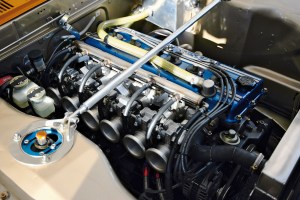
The timing on a carbureted engine is always a compromise.
Advance Curves
Static timing is the level at which the manufacturer initially sets the engine – commonly around 10 degrees after Top Dead Centre (TDC). High engine speeds can increase that to around 32 degrees, but the point is that on a traditional distributor, getting from 10 to 32 degrees can only occur at a linear rate, simply because it’s mechanically controlled. Thus, if you plotted a graph of degrees against engine speed then you’d get a smooth curve.
Therefore, on a traditional carburetor engine, with a twin choke, it’s really only possible to plot a compromise curve that’s correct for both idle and full throttle. Everything in between has to be an educated guess! Having said this, you can alter the curve by changing the springs that hold back the centrifugal advance mechanism in the distributor, although you’ll only be making it act faster or slower. The ideal solution is to have a curve for every ignition requirement – or, in other words, mapped ignition.

Mapped Ignition
As ignition systems have developed over the years, the aim has always been to eliminate mechanical factors and aim for constant dwell. Despite spark-boosting systems, the distributor has often controlled advance. Eliminating this variable can only be effectively controlled by going digital with a computer – enter the ECU. This stores data determined by rolling-road sessions in its memory and is able to ‘look up’ parameters and apply them according to pre-determined settings of fuel, engine temperature, load, speed and positioning.
This is what you need to determine when mapping a car. Technicians plot a 3D graph of load vs engine speed vs ignition angle, giving an accurate setting for virtually every common ignition point, rather than a compromise. And you don’t have to have just one map either – most current ECUs have the provision for ‘switchable maps’ according to the driving situation – fast road, track or economy. So, by depriving our engine of mechanical parts, we gain performance, reliability and economy – result all round!

